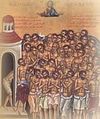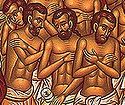

| Previous day | Next day |
| Old Style
March 9
|
Friday |
New Style
March 22
|
|
2nd Week of Great Lent.
Tone 1.
Great Lent. |
Monastic rule: xerophagy (bread, uncooked fruits and vegetables).
|
![]() The Holy Forty Martyrs of Sebaste: Cyrion (or Quirio), Candidus, Domnus, Hesychius, Heraclius, Smaragdus, Eunoicus, Valens, Vivianus, Claudius, Priscus, Theodulus, Eutychius, John, Xanthias, Helianus, Sisinius, Angus, Aetius, Flavius, Acacius, Ecdicius, Lysimachus, Alexander, Elias, Gorgonius, Theophilus, Dometian, Gaius, Leontius, Athanasius, Cyril, Sacerdon, Nicholas, Valerius, Philoctimon, Severian, Chudion, Aglaius, and Meliton (ca. 320).
The Holy Forty Martyrs of Sebaste: Cyrion (or Quirio), Candidus, Domnus, Hesychius, Heraclius, Smaragdus, Eunoicus, Valens, Vivianus, Claudius, Priscus, Theodulus, Eutychius, John, Xanthias, Helianus, Sisinius, Angus, Aetius, Flavius, Acacius, Ecdicius, Lysimachus, Alexander, Elias, Gorgonius, Theophilus, Dometian, Gaius, Leontius, Athanasius, Cyril, Sacerdon, Nicholas, Valerius, Philoctimon, Severian, Chudion, Aglaius, and Meliton (ca. 320).
Martyr Urpasianus of Nicomedia (ca. 295). St. Caesarius, brother of St. Gregory the Theologian (ca. 369). St. Tarasius the Wonderworker, of Lycaonia. Translation to Vladimir of the relics of Martyr Abraham of the Bulgars on the Volga (1230). St. Jonah, archbishop of Novgorod (1470). St. Theodosius Levitsky, priest, of Balta (Odessa) (1845). St. Dimitra, nun and foundress of the Vvedensk Convent in Kiev (1878).
New Hieromartyrs Mitrophan Buchnoff, archpriest, of Voronezh (1931), and Ioasaph (Shakhov), abbot, of Popovka (Moscow) (1938). New Hieromartyrs Sergius Lebedev, Sergius Tsvetkov, and Alexis Smirnov, archpriests, and Dimitry Glivenko, priest, all of the Moscow region (1938).
“Albazin” Icon of the Most Holy Theotokos (“The Word Was Made Flesh”) (1666).
St. Philoromus the Confessor, of Galatia (4th c.). St. Pacianus, bishop of Barcelona (390). St. Bosa, bishop of York (705). St. Vitalis of Castronovo (994). New Martyrs (two priests and forty students) of Momisici (Montenegro) (1688).
Repose of Elder Cleopas of Ostrov-Vvedensk Monastery (1778) and Schema-archimandrite Theophilus of Kiev (1996).
Thoughts for Each Day of the Year
According to the Daily Church Readings from the Word of God
By St. Theophan the Recluse

Friday.
My Spirit shall not always strive with man, for that he also is flesh (Gen. 6:3).[1] Man has two opposing forces inside, but one consciousness—the human being. The characteristics of this being are determined by his inclinations. If he sides with the Spirit, he is spiritual; if he sides with the flesh, he is fleshly. The spirit does not disappear altogether even from the fleshly, but it is enslaved, and has no voice. It becomes yoked, and serves the flesh like a slave serves its mistress, inventing all sorts of pleasures for it. Similarly, the flesh does not disappear from the spiritual, but it submits to the spirit and serves it. It loses its natural rights for food through fasting, its rights for sleep through vigil, for rest through continuous labour and weariness, for pleasing the feelings through seclusion and silence. Where the flesh reigns, God does not abide; for His organ of communication with man is the spirit, which is not given its due priority in the flesh. God’s approach is felt for the first time when the spirit begins to claim its own through the operation of the fear of God and one’s conscience. When consciousness and freedom also come to help, then God communicates with man and begins to dwell in him. From that moment on begins the inspiration of the soul, the flesh and of the entire inner and outer man, while God becomes all in all in him. By becoming spiritual, man is made divine. What a marvellous benefit, and how little it is remembered, valued and sought after!
[1]The Slavonic for Gen. 6:3 reads: My Spirit shall not eternally be scorned by men, because they are flesh.
Articles
 Martyr Urpasianus of NicomediaThe Holy Martyr Urpasianus suffered in the city of Nicomedia. |
 St. Caesarius, brother of St. Gregory the TheologianSaint Caesarius lived for a long time at the court of the emperor Constantius (337-361), and was his friend and chief court physician. |
 Icon of the Mother of God “The Word was made Flesh”The Albazin Icon of the Mother of God “the Word made Flesh” is of great religious significance in the Amur River region. |






